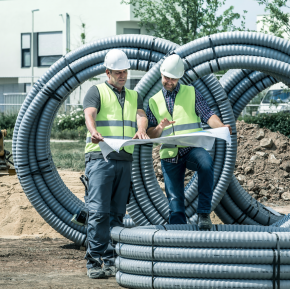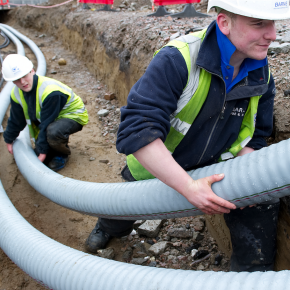
District heating is the viable alternative
Steve Richmond, Head of Marketing & Technical at REHAU Building Solutions’ division, discusses how companies are advancing the new generation of district heating solutions.
Driven by government plans to reduce carbon emissions and cut consumer energy bills, district heating networks are fast becoming the ideal choice for heating our homes and buildings. Environmental conservation and the move to renewable energy sources are rendering fossil fuel boilers a less attractive proposition going forward, leaving room for more efficient and innovative solutions.
 A wider awareness of climate change has meant that companies are having to adapt and innovate solutions to meet new priorities, particularly in the energy sector. With fossil fuel boilers struggling for relevance in these eco-conscious conversations, attention has shifted towards more efficient heating systems that reduce household energy bills and carbon emissions.
A wider awareness of climate change has meant that companies are having to adapt and innovate solutions to meet new priorities, particularly in the energy sector. With fossil fuel boilers struggling for relevance in these eco-conscious conversations, attention has shifted towards more efficient heating systems that reduce household energy bills and carbon emissions.
Within a district heating system, large centralised heat source supply buildings across the network with hot water via underground pre-insulated pipes. By supplying multiple buildings from a single source, carbon emissions can be reduced alongside the costs and time required for maintaining individual boilers.
The third generation of district heating network is currently the most widely implemented across Europe, with water circulating at 70-95oC flow temperature. However, new fourth-generation networks are beginning to be established with water circulating at 40-60oC, which not only lessens heat being lost or wasted within the network, but is also at a perfect range for waste heat or heat pumps. As well as reducing the network’s carbon emissions, this also efficiently meets consumer demand, lowering household energy bills further.
Key developers are beginning to see these fourth-generation networks as an attractive alternative that can lower capital and operational costs via reduced heat loss and smaller pipe sizes and the resulting savings. It is also a more attractive proposition for local authorities as lower costs of installation and maintenance make lowering energy bills much more feasible.
As for their environmental impact, fourth-generation networks using a centralised air, water or ground source heat pump are ideally suited to lower flow temperatures. With a significant reduction in carbon emissions compared to their gas-powered equivalents, fourth-generation district heating networks are now a viable solution for a more efficient and sustainable future energy sector.
Lowering carbon emissions
Proposals to improve energy efficiency and reduce emissions across the heating market outlined in the Committee for Climate Change’s (CCC) February 2019 report have made the move to district heating more pressing than ever. The report has guided the Government in their establishment of a policy aiming to achieve a net-zero rate of carbon across the UK by 2050, and led to the launch of the Future Homes Standard for 2025, which bans the installation of fossil fuel boilers in any new builds.
This situation has further highlighted district heating networks as a favoured solution, as developers must consider the lower flow temperature systems to adhere to these policies. This is especially true given that the CIBSE / ADE CP1 – the code of practice setting out minimum requirements for a heat network – recommends new systems to have a maximum flow temperature of 70oC.
The tenth version of the Standard Assessment Procedure for building regulations (SAP10), currently out for consultation and coming into effect in 2020, also favours heat pumps as an alternative as a result of new lower emissions factors for electricity. The current SAP 2012 regulations denoted a value of 0.519 kgCO2/kWH to be adhered to, which under SAP 10 was reduced to 0.233. In the latest draft SAP 10.1 consultation published on 1st October 2019, this figure was reduced further to 0.136, a 75% improvement in electricity carbon savings from heat pump use compared to the original SAP 2012 figures.
In addition to this, commercial-scale heat pumps and very low or ambient temperature distribution systems are being encouraged by the Heat Networks Investment Project (HNIP) when it comes to grants or loans being awarded to projects. All these aspects point towards a swift trend in decarbonisation and demonstrate that low carbon heat pumps are a viable alternative.
Efficiency with polymer
Thanks to carbon and cost savings driving the move to district heating, the appeal of modern efficient heat networks is higher than ever, particularly those that are polymer-based. Companies such as REHAU are producing solutions that provide efficient space heating and hot water at the same time as lowered emissions and reduced energy bills in line with demand from consumers, government bodies and developers.
Though polymer’s involvement in district heating solutions is in the relatively early stages, government studies have already begun to highlight their lower installation costs in comparison to their traditional material counterparts.
Traditional steel pipework can incur corrosion that often ends in costly repair or replacement work. These disadvantages associated with corrosion are minimised with polymer solutions and, in addition to this, the reduced flow temperatures of fourth-generation networks afford polymer pipes a lifespan of well over 50 years. Developers and contractors can also make the most of flexibility from polymer solutions throughout the design process and later on-site, with quick and easy installation that requires no welding to connect pipework.
RAUVITHERM and RAUTHERMEX, pre-insulated pipework systems from REHAU, are proven reliable solutions for use in district heating networks. Small or medium-sized networks would benefit from the combination of flexibility and low heat losses from RAUVITHERM. For larger heat networks, the insulation from the high-performance polyurethane rigid (PUR) foam that RAUTHERMEX uses ensure minimal heat losses, enhancing system efficiency yet further.
Fifth-generation networks circulating at 10-30oC are also developing alongside the higher temperature fourth generation. In these types of systems, individual heat pumps in each building boost the heat using the supply from the low-temperature ambient network, and the lower circulation temperature means yet further reductions in distribution heat losses.
Using polymer solutions such as those from REHAU, developers, specifiers and contractors can keep up with the rapidly changing district heating market, which is beginning to look beyond from traditional fossil fuel heat pumps and focus on renewable energy-powered alternatives. With carbon reduction at the forefront of the heating sector, heating homes and buildings with district heating networks is fast becoming a more viable option.
Contact:
REHAU
Hill Court,
Walford,
Ross on Wye,
Herefordshire,
HR9 5QN
Email address: [email protected]
Tel: 01989 72600
Visit Supplier's page
Latest news

19th April 2024
ASSA ABLOY: Access solutions can impact sustainability performance across the full life-cycle of a building
Embedding sustainability within any organisation requires a broad, strategic perspective. Scrutiny should include the physical infrastructure itself: According to the IEA, buildings consume around 30% of global energy*. ASSA ABLOY has more…
Posted in Access Control & Door Entry Systems, Architectural Ironmongery, Articles, Building Industry News, Building Products & Structures, Building Regulations & Accreditations, Building Services, Case Studies, Doors, Facility Management & Building Services, Information Technology, Research & Materials Testing, Retrofit & Renovation, Security and Fire Protection, Sustainability & Energy Efficiency, Video of the Week
19th April 2024
British weather doesn't dampen spirit for new HMG Garden Paint
Despite one of the wettest starts to the year on record, customers are starting to plan for brighter days with HydroPro Garden Paint from HMG Paints.
Posted in Articles, Building Industry News, Building Products & Structures, Garden, Innovations & New Products, Paints, Paints, Coatings & Finishes, Restoration & Refurbishment, Retrofit & Renovation, Site Preparation, Sustainability & Energy Efficiency, Waste Management & Recycling
18th April 2024
Abloy UK showcases new digital portfolio at The Security Event 2024
Abloy UK is set to unveil its latest line-up of access control systems at The Security Event 2024, welcoming guests to explore its cutting-edge electromechanical and digital solutions on stand 5/F50.
Posted in Access Control & Door Entry Systems, Architectural Ironmongery, Articles, Building Industry Events, Building Industry News, Building Products & Structures, Building Services, Doors, Exhibitions and Conferences, Facility Management & Building Services, Health & Safety, Information Technology, Retrofit & Renovation, Security and Fire Protection
18th April 2024
Strand is a Failsafe Choice for Emergency Exit and Panic Hardware
In times of emergency, you’re in safe hands with Strand Hardware. Although there are many considerations for building specification, few decisions can be as critical as selecting the right emergency exit/panic hardware.
Posted in Access Control & Door Entry Systems, Architectural Ironmongery, Articles, Building Industry News, Building Products & Structures, Building Services, Doors, Facility Management & Building Services, Health & Safety, Restoration & Refurbishment, Retrofit & Renovation, Security and Fire Protection
 Sign up:
Sign up: